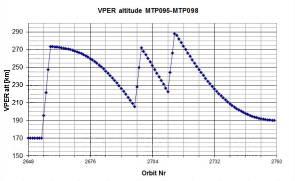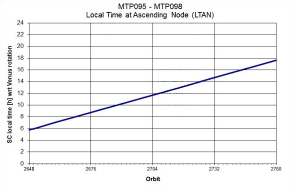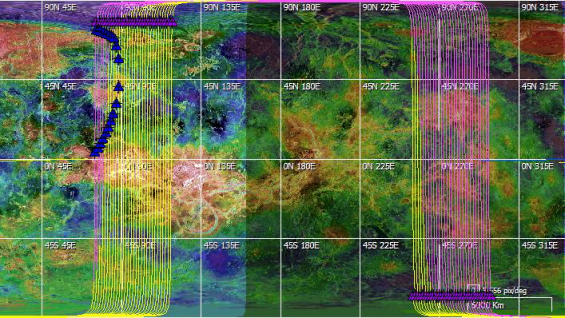No. 263 - Completion of the twelfth Atmospheric Drag Experiment campaign, end of the fifteenth Earth occultation season, and start of the first sulphur dioxide campaign
Cebreros ground station
All Cebreros ground station activities were nominal during this reporting period.
Spacecraft clock synchronised
The clock on the Venus Express spacecraft is a simple count-up timer, typical of those used on spacecraft. These clocks save weight and cost but they tend to drift, and must be synchronised – or correlated – with atomic clocks on Earth at regular intervals. One of these regular time correlations was performed on 9 August after the Cebreros communication pass. The new time correlation was applied starting from 9 August at 07:15:00 UTC.
End of the twelfth Atmospheric Drag Experiment campaign
The twelfth Atmospheric Drag Experiment campaign continued during this reporting period. The final seven passes of the campaign were performed between 21 and 27 July. The pericentre altitude was reduced to 170 km during the campaign to help obtain data on the density of the upper atmosphere.
The safety requirements during ADE campaigns require many more checks than usual, greatly increasing the workload on the flight control and flight dynamics teams. This includes daily Go/No Go calls to make decisions on the management of the solar array rotation angles – the angle is used to determine the magnitude of atmospheric resistance and hence the atmospheric drag. Escape manoeuvres are also calculated daily, in case unexpectedly high torques caused by the atmosphere require a rapid response.
The campaign proceeded smoothly and ended on 27 July. An orbit correction manoeuvre raised the pericentre altitude on 28 July.
Read more information about ADE campaigns here.
End of the fifteenth Earth occultation season
The fifteenth Earth occultation season ended on 31 July.
Occultation measurements were obtained twice during this reporting period. These observations can only be obtained at pericentre, and conflicted with the higher priority observations of the ADE campaign and the sulphur dioxide (SO2) observation campaign. Therefore, the occultation observations were performed after the end of the twelfth ADE campaign, and before the start of the first SO2 campaign, on 28 and 29 July.
The spacecraft radio signal is received on Earth at the New Norcia (NNO) ground station in western Australia (also known as Deep Space Antenna, DSA-1). The NNO station is used for radio science because the Venus Express orbit is 24 hours long, and NNO always has the best viewing angle to Venus when the spacecraft is at pericentre.
For more information, please see 'Venus Express Earth occultation seasons'.
Start of the first sulphur dioxide campaign
Observations of SO2 in the Venusian atmosphere took over as the scientific priority for Venus Express at the end of the twelfth ADE campaign on 27 July; these observations will remain the mission's scientific priority for the next four months. SO2 is found in small concentrations in other planetary atmospheres. At Venus, however, it is a significant component of the atmospheric chemistry and even forms clouds.
The SO2 observations are performed using SPICAV (Spectroscopy for Investigation of Characteristics of the Atmosphere of Venus), a spectrometer designed to obtain profile measurements (soundings) of the atmosphere during solar and stellar occultations. For SO2 observations, however, SPICAV is pointed at the nadir (down at the planet instead of the limb as is usual in occultation observations) and observes the sunlight reflected off the clouds. The instrument pointings consist of slews, from one side of the sub-satellite (nadir) point to the other, on the illuminated day-side of the planet.
SO2 nadir observations were performed in almost every other orbit beginning 30 July.
Orbit correction manoeuvres
 |
| Change in Venus Express pericentre altitude with time from 21 July to 9 November 2013. Credit: ESA |
Five orbit correction manoeuvres (OCMs) were carried out during this reporting period. The first four were prograde (in direction of travel), performed at the orbit apocentre to raise the pericentre altitude. The final burn was a retrograde manoeuvre, and was performed at orbit pericentre to lower the altitude of the apocentre.
At this stage of the mission, with low fuel levels on the spacecraft, the orbit correction manoeuvres are carried out as a number of small burns – rather than fewer large burns – to ensure that they are performed accurately. An explanation for this can be found in Status Report no. 257.
The four prograde OCMs were executed at successive apocentres from 27 to 30 July. Each of the first three had a nominal magnitude of 1.600 m/s; the fourth prograde OCM had a nominal magnitude of 1.525 m/s. They were designed to raise the pericentre altitude so that after the last OCM the Venus Express orbital altitude would be 103 km higher than before the first, with a corresponding increase in the orbital period of 170 s.
The accuracy of the burns was determined to be:
- 1st OCM: underperformance of 0.25%, the change in speed fell short of the target by 3.9 mm/s;
- 2nd OCM: over performance of 0.07%, the change in speed exceeded the target by 1.1 mm/s;
- 3rd OCM: underperformance of 0.23%, the change in speed fell short of the target by 3.8 mm/s;
- 4th OCM: underperformance of 0.18%, the change in speed fell short of the target by 2.7 mm/s.
As a result of the over/underperformance of the engine burns during the pericentre raising manoeuvres, the final pericentre altitude fell short by 107 m, and the increase in the orbital period fell short by 0.17 s, compared to the expected values.
The fifth OCM of this reporting period was carried out on 11 August at orbit pericentre. The targeted speed change was 545.69 mm/s. The manoeuvre was retrograde, carried out to lower the apocentre altitude by 100 km and decrease the orbital period by 165 s.
The orbit determination after the burn showed an underperformance of 0.14%; the change in speed was 0.78 mm/s less than the planned value. The apocentre altitude decreased by 140 m less, and the orbital period by 0.23 s less, than targeted values.
Summary of main activities
| Main activities during reporting period | |||
| ADE = Atmospheric Drag Experiment; CAN = Canberra; CEB = Cebreros; DOY = Day of year; MET = Mission elapsed time; NNO = New Norcia; OCM = Orbit Correction Manoeuvre | |||
|
MET (Day) |
Date | DOY | Main Activity |
| 2812 | 21-Jul-2013 | 202 | ADE pass at pericentre, CEB communications pass. |
| 2813 | 22-Jul-2013 | 203 | ADE pass at pericentre, CEB communications pass. |
| 2814 | 23-Jul-2013 | 204 | ADE pass at pericentre, CEB communications pass. |
| 2815 | 24-Jul-2013 | 205 | ADE pass at pericentre, CEB communications pass. |
| 2816 | 25-Jul-2013 | 206 | ADE pass at pericentre, CEB communications pass. |
| 2817 | 26-Jul-2013 | 207 | ADE pass at pericentre, CEB communications pass. |
| 2818 | 27-Jul-2013 | 208 | ADE pass at pericentre, CEB communications pass. Apocentre OCM to raise pericentre. |
| 2819 | 28-Jul-2013 | 209 | Occultation pass on CAN. CEB communication pass. Apocentre OCM to raise pericentre. |
| 2820 | 29-Jul-2013 | 210 | Occultation pass on NNO. CEB communication pass. Apocentre OCM to raise pericentre. |
| 2821 | 30-Jul-2013 | 211 | CEB communication pass. Apocentre OCM to lower apocentre. |
| 2822 | 31-Jul-2013 | 212 | CEB communication pass. |
| 2823 | 01-Aug-2013 | 213 | CEB communication pass. |
| 2824 | 02-Aug-2013 | 214 | CEB communication pass. |
| 2825 | 03-Aug-2013 | 215 | CEB communication pass. |
| 2826 | 04-Aug-2013 | 216 | CEB communication pass. |
| 2827 | 05-Aug-2013 | 217 | CEB communication pass. |
| 2828 | 06-Aug-2013 | 218 | CEB communication pass; pass shortened for CEB maintenance. |
| 2829 | 07-Aug-2013 | 219 | CEB communication pass; pass shortened for CEB maintenance. |
| 2830 | 08-Aug-2013 | 220 | CEB communication pass. |
| 2831 | 09-Aug-2013 | 221 | CEB communication pass. |
| 2832 | 10-Aug-2013 | 222 | CEB communication pass. |
| 2833 | 11-Aug-2013 | 223 | CEB communication pass. Pericentre OCM to raise pericentre. |
| 2834 | 12-Aug-2013 | 224 | CEB communication pass. |
| 2835 | 13-Aug-2013 | 225 | CEB communication pass. |
| 2836 | 14-Aug-2013 | 226 | CEB communication pass. |
| 2837 | 15-Aug-2013 | 227 | CEB communication pass. |
| 2838 | 16-Aug-2013 | 228 | CEB communication pass. |
| 2839 | 17-Aug-2013 | 229 | CEB communication pass. |
At the end of the reporting period on 17 August, Venus Express was 183.6 million km from Earth. The one-way signal travel time was 612 s. The final oxidizer mass was 16.955 kg and the final fuel mass was 10.347 kg.
Scientific focus
This reporting period falls under the ninety-fifth medium term planning period (MTP), which covered the period from 21 July to 17 August 2013. The twelfth Atmospheric Drag Experiment campaign and the fifteenth Earth occultation season ended during this planning period, on 27 and 31 July respectively.
After the end of the twelfth ADE campaign on 27 July, SO2 measurements became a scientific priority for Venus Express and will remain a priority for the next four months. Therefore, day-side SO2 nadir observations were performed as often as possible beginning 30 July. These were preceded by Venus Monitoring Camera (VMC) cloud-tracking observations whenever possible.
Occultation observations were carried out with the Venus Radio science instrument (VeRa) during two suitable orbits at the end of the twelfth ADE campaign and before the start of the SO2 observation campaign, on 28 and 29 July.
As the SO2 observations had higher scientific priority, no eclipse or occultation observations were carried out after 29 July.
 |
| Venus Express LTAN from 21 July to 9 November 2013. Credit: ESA |
The local time at ascending node (LTAN) changed from 05:45 hrs to 08:45 hrs during this reporting period. An LTAN value of 06:00 corresponds to an orbit over the planet's terminator at dawn, the spacecraft is illuminated while in the ascending branch of its orbit. The observing season was 'hot' after the first few orbits: nadir pointing would illuminate sensitive faces of the spacecraft, limiting the duration of such observations due to thermal constraints.
For more information on LTAN, please see 'Terminator Orbits'.
The data rate was low-to-medium but was starting to rise.
 |
| Venus Express coverage of Venus from 21 July to 17 August 2013. Credit: ESA |
Payload activities
One instrument anomaly was noted during this reporting period.
| ASPERA | The instrument was regularly operated nominally as part of the routine plan. |
| MAG | The instrument was regularly operated nominally as part of the routine plan. |
| PFS | The instrument was not operated. |
| SPICAV | The instrument was regularly operated nominally as part of the routine plan. |
| VMC |
The instrument was regularly operated nominally as part of the routine plan. The VMC experienced another instance of the instrument not executing commands in three orbits. The camera failed to obtain 11 images on 31 July, 13 images on 11 August, and one on 12 August. In each instance, VMC continued to operate and process other commands, including a scheduled turn-off. After the next instrument turn-on, all commands executed correctly and the planned operations continued nominally. |
| VeRa | The instrument was regularly operated nominally as part of the routine plan. |
| VIRTIS | The instrument was regularly operated nominally as part of the routine plan. |
Future milestones
- Start of in-bound quadrature configuration
- High-altitude aerobraking flight test on 19 November 2013
Legal disclaimer
This report is based on four ESOC mission operations reports, MOR 399 through MOR 402, as well as the MTP095 Master Science Plan. Please see the copyright section of the legal disclaimer (bottom of this page) for terms of use.



